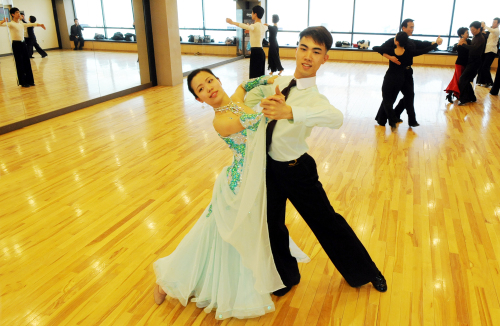Lee, who began dancing at 50, said has found the sport inspiring.
“I never thought I’d be in a position to compete in a sports competition, but I’ve already done it with this dance sport. It really makes me feel more confident.”
It is fun to dance to the music, but, in fact, dance sport requires just as much, if not more, time and effort as other sports, according to Jung.
“Golf swing, for instance, uses only one side of you body. But you’ve got to twist your whole body when you dance,” she added.
“Waltz or something with a fast beat, you need to do quick dance steps, more than 180 steps in less than one minute,” Baek explained further.
So dance sport is a great work out, but finding the right dance might take experimentation. There are different types and styles and each brings its own unique advantages.
Ballroom or Latin?
Dance sport usually refers to the ballroom or standard and Latin style dances, now regulated by the World Dance Council. For standard dances, couples usually dance counter-clockwise, making a circle around the dance floor.
Participants of Latin dances, however, do not normally follow the line of dance, rather they stay in one spot during approximately 90 seconds of their routine.
Standard dances include waltz, foxtrot, tango and quickstep, while Latin dances consist of samba, cha-cha-cha, jive and rumba.
Waltz, which dates back to the 17th century, is still popular across the globe. Its movements are based on the three basic steps ― a step forward, backward and a step to the side.
“Waltz is slow, and includes basic elements found in most other dances, so it is suitable for beginners,” Jung said.
Meanwhile, foxtrot is highly versatile and can be danced to a variety of tempos, from slow and romantic music to quick and jazzy.
As for tango, it is a passionate and dramatic dance. Al Pacino danced it in the movie “Scent of a Woman.”
And it is somewhat different from other dances. Unlike waltz and foxtrot, it has no swaying moves. Instead, it involves quick and sharp movements, based on counts of eight.
In contrast, rumba is a slow and romantic dance, which is usually danced to four beats music. So learning rumba is also not difficult and highly recommended for beginners.
Cha-cha-cha is widely recognizable by its catchy rhythm ― one, two, cha-cha-cha. It is also easy to learn and fun to dance.
Salsa and jive dancing are similar. Both have a pattern of six steps over eight counts of music, though there is no difficult footwork in jive.
Whether it is salsa or jive, dancing is fun. And it is sure to help you work up a sweat.
“Professional dancers, like me, practice up to six hours every day, 30 hours a week,” said instructor Kim Jeong-hyun.
“I think it beats running on a pitch for a half an hour,” he added.
Kim, 22, who began his professional career four years ago, claimed that the benefits of dance sport go beyond the physical and include emotional and social intellectual.
“Dance sport is a team sport. You can’t dance without a partner. And you need to develop a good relationship with your partner to perform well,” he said.
Dance sport is still not popular here compared with other traditional sports such as baseball, football and basketball. But popularity is rapidly developing.
Last year, the national team helped boost the sport’s popularity by showing excellent results at the Guangzhou Asian Games, where they garnered seven silver and three bronze medals.
Also, popular foreign television programs such as “Dancing with the Stars,” and “Strictly Come Dancing,”― the Korean version is due to air from this summer ― have shown us that dancing is not only enjoyable but a real workout.
With the inspiration of dancing shows on TV, and studios popping up around the city, the instructor expects growing numbers of people to skip the gym and step onto the dance floor instead.
If you have never tried it, why not give it a go this weekend?
Not good at dancing? Don’t worry, you can learn the basic steps and will soon find yourself moving your hips to salsa music or shaking your legs in a cha-cha-cha rhythm.
So, shall we dance?
By Oh Kyu-wook (
596story@heraldcorp.com)
Where to Dance
To find out more about La Luce dance studio visit
http://cafe.daum.net/danceasfire.
There are now almost 6,000 venues across the country — offering a variety of dance lessons.
For more details, check the Korean Federation of Dancesport’s website at
www.kfds.or.kr or call (02) 4152-0901, where you can also find information on regular and special dances, as well as competitions.








